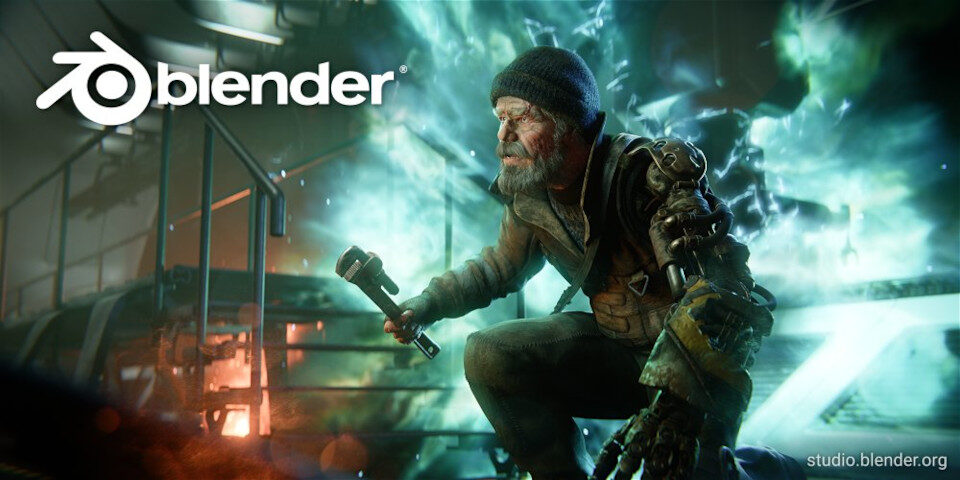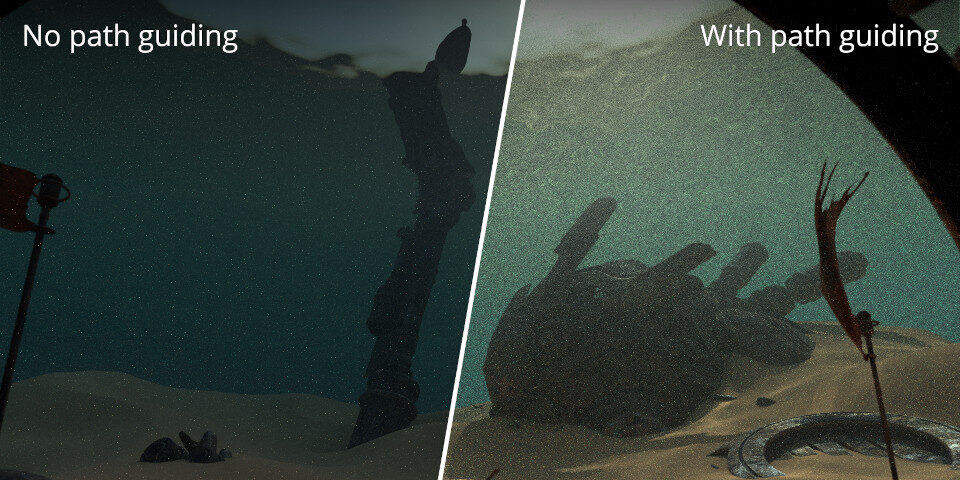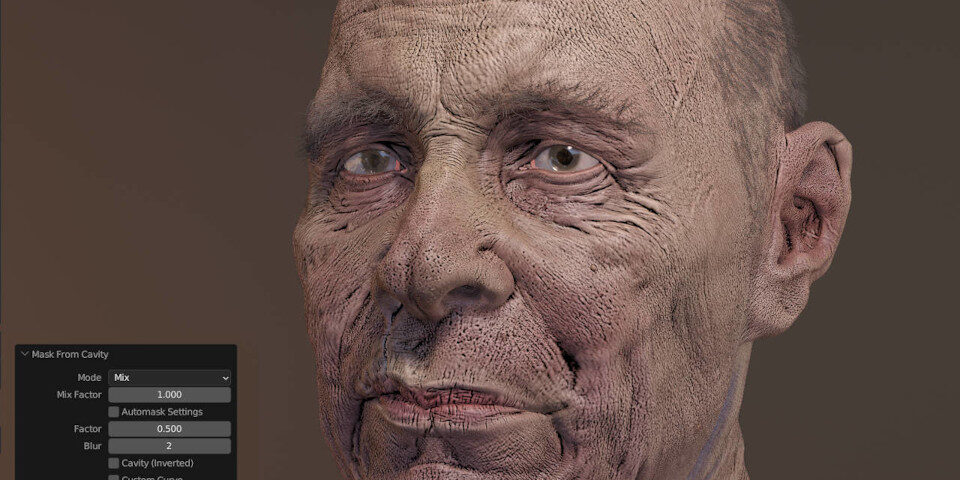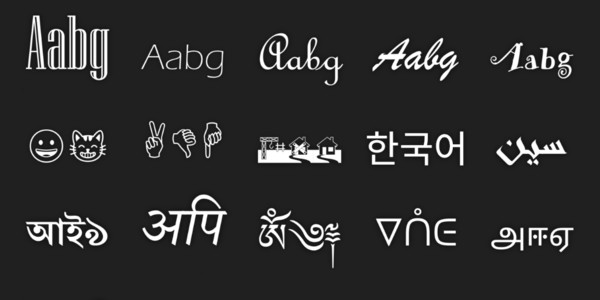5 key features in Blender 3.4

Main image: Blender 3.4’s splash screen art, from Blender Studio animation Charge (Project Heist).
The Blender Foundation has released Blender 3.4, the latest version of the open-source 3D software.
New features include path guiding for faster renders in Cycles, new auto-masking options when working in Sculpt mode, and the latest updates to the steadily evolving Geometry Nodes system.
Below, we’ve picked out five of the most significant changes, along with smaller updates to the core toolset, including animation and file import – plus a bonus feature for motion graphics artists.

Renders generated in equal time without and with path guiding enabled in Cycles. Path guiding helps Cycles to resolve parts of scenes with complex indirect illumination – such as this water volume – more quickly.
1. Path guiding in Cycles
If the mark of a significant change is simply that it generates attractive demo images, unquestioned #1 feature in Blender 3.4 is support for path guiding in the Cycles renderer.
With path guiding enabled, Cycles analyses the light distribution in a scene and uses that information to ‘guide’ the light paths that make the most significant contributions to a render.
By prioritising paths that interact with surfaces in the scene, path guiding improves sampling, helping the render to resolve to an acceptably low level of noise more quickly.
Its effect is most noticeable in scenes with complex indirect lighting, such as multi-bounce diffuse illumination or multi-scattering in volumes like clouds.
(It can also help with rendering simple caustics, as in the image above, although unlike Manifold Next Event Estimation, introduced in Blender 3.2, it isn’t specifically designed for the task.)
The feature was implemented using Intel’s new Open Path Guiding Library (Open PGL), and is currently only available when rendering on CPU.
2. More updates to Geometry Nodes
Blender 3.4 isn’t the ‘big’ update to Geometry Nodes – that’s Blender 3.5, when the node system is due to evolve from a procedural modelling and object scattering toolset into a procedural simulation framework.
However, there are still a number of important changes, such as the option to use the Viewer node to preview the output of a node tree in the viewport, not just the Spreadsheet.
That should make debugging node networks a more intuitive process, as shown in the video above.
Other key changes include the option to retrieve the attributes of instances created by geometry nodes, making it possible to use instances in more creative ways, such as this sprite-based real-time fire effect.
There are also new sets of nodes for retrieving topology information for meshes and curves, plus Distribute Points in Volume, which creates points inside volume grids.

3. Neat new auto-masking options in Sculpt mode
The Auto-Masking options in Blender’s Sculpt mode have been extended in Blender 3.4, providing new ways to mask out parts of the surface of a model for sculpting or 3D painting.
It is now possible to generate a cavity mask automatically for a sculpt – such as the one used to paint the dirt in the pores of the face of the character above – rather than having to apply one manually.
Users can fine tune the results via controls to invert or blur the mask, or to change its blend mode.
It is also now possible to mask a sculpt by viewpoint, making it possible to paint only those parts of its surface visible from a given direction.
4. New geometry-based UV relax brush
Blender’s UV tools gets a number of updates, the biggest being the new geometry-driven relax brush mode.
Unlike using the existing Relax brush in 2D texture space, it makes the UVs follow the geometry of the model more closely, as shown in the video above, improving the quality of the UV mapping.
There are also new options for packing UVs, adjusting UV islands, and customising the background grid in Blender’s UV Editor.
5. New Storypencil add-on for storyboarding
Outside the core application, Blender 3.4 gets a new storyboarding add-on, Storypencil, developed by the same team responsible for Blender’s Grease Pencil 2D animation toolset, and already tested in production.
Although it’s already possible to create an animated storyboard using Grease Pencil, Storypencil ties into Blender’s Video Sequence Editor, making it much easier to reorder or retime shots.
It exports both video and image sequences, making it possible to create animatics or static storyboards.
Updates to other core toolsets
The upcoming Animation 2025 project notwithstanding, Blender’s character rigging and animation toolsets only get a few workflow updates in Blender 3.4.
The NLA, Dopesheet, and Timeline editors now have a self-descritive Redo panel, and it is now possible to ‘mute’ drivers via a checkbox in the Driver Editor and Edit Driver popover.
Grease Pencil sees more substantial changes, including a new algorithm for closing gaps between paint strokes when colouring line art using the Fill tool.
Other new features include an Outline modifier, for generating a perimeter stroke from the camera view, and the option to import multiple SVG files in one go.
Eevee, Blender’s real-time renderer only gets new feature: headless rendering on Linux.
Changes to file import and export include support for FFmpeg AV1 encoding, making it possible to export videos encoded using the new AV1 codec.
Blender also now supports PBR extensions in the .mtl material files referenced by models in OBJ format, including roughness, metallic, sheen, clear coat and anisotropy parameters of Principled BSDF materials.

And a bonus for motion graphics artists
And finally, although they only occupy a single line in the official feature summary, there are quite a few changes to the way that Blender handles fonts in Blender 3.4.
The existing two fonts have been replaced with a stack of new fonts to increase language coverage – Blender now supports the 44 languages most commonly used worldwide – and add new symbols and icons.
In addition, font thumbnails have been improved, as has the display of the cursor when editing 3D text objects in the viewport: good news for motion graphics artists, or anyone else who works with text.
System requirements
Blender 3.4 is available for Windows 8.1+, macOS 10.13+ and Linux. It’s a free download.
See Blender Foundation’s overview of the new features in Blender 3.4
